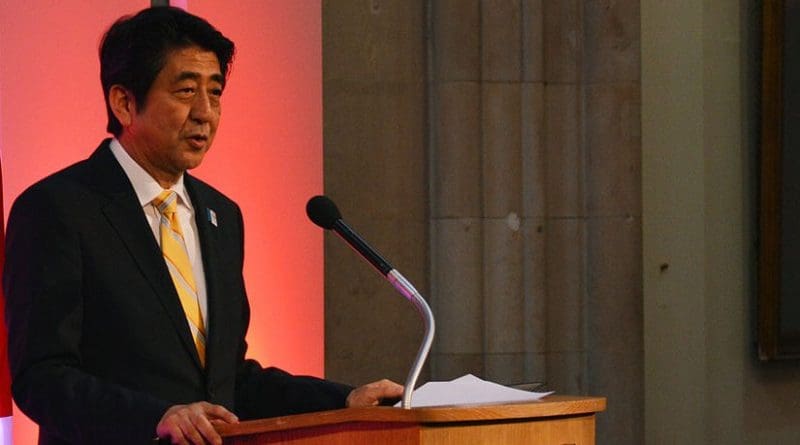Abe Looks For Path Through Minefield Between US And China – OpEd
By Arab News
By Andrew Hammond*
Shinzo Abe on Thursday starts the first official trip to China by a Japanese prime minister in seven years. Amidst brewing bilateral tensions, and a legacy of bitter memories of World War II, a Donald Trump-sized window of opportunity may nonetheless now exist for a significant thawing of ties.
Both Beijing and Tokyo have been disorientated by Washington in the two years since Trump was elected. Especially following Vice President Mike Pence’s hard-hitting speech against China this month, in which he launched an unexpectedly stinging attack, Beijing does not anticipate any significant warming of ties with Washington in the immediate future.
Meanwhile, despite the apparent personal positivity between Trump and Abe, Tokyo has been increasingly alarmed by the US administration’s continued undermining of the post-war economic and political order. This includes US sanctions that threaten key national industries, including the auto sector.
It is in this disruptive context that this week’s talks take place between Xi Jinping and Abe. They will discuss the latest moves to rebuild relations, including through potentially shared agendas like building economic infrastructure in Asia-Pacific. Yet, while the mood music is positive, for now at least, distrust and competition continue to define much of their relationship.
The sensitive and precarious nature of the trip is underlined by the changing start date. It was previously scheduled to commence on Tuesday — the 40th anniversary of former Chinese leader Deng Xiaoping’s visit to Japan in 1978 to ratify the Sino-Japanese peace and friendship treaty. But it was ultimately pushed back to Thursday. This was, in part, because Tuesday also marked the 150th anniversary of the Meiji Restoration, which paved the way for Japan to become an important player on the international stage.
For China this is an understandably sensitive date, given that the Meiji era saw the first war between the two nations, which saw Japan winning new territory in 1894-95. And it also, in turn, began a series of conflicts that were the precursors for the 1931 Manchurian Incident and the Second Sino-Japanese War of 1937-45.
This underlines that, while bilateral relations are no longer in the deep freeze, there remains significant scope for tension. Only last week, for instance, Tokyo submitted its latest official protest to Beijing after Chinese ships cruised around disputed islands in the region, which are called Senkaku by Japan and Diaoyu by China.
Going forward, the strategic dilemma over future relations is particularly acute for Abe as he seeks to navigate a domestic and foreign policy pathway through the economic and security minefield of retaining relations with Washington while seeking better bonds with Beijing. With Xi now set to be in power into the 2020s, this headache could become more acute for Tokyo if Trump is re-elected in 2020 too.
Abe has to work out how best to respond to China’s growing influence in Asia-Pacific in the context of the uncertainties that Trump’s presidency has brought, including its departure from the Trans-Pacific Partnership, which has provided a new opportunity for Beijing to assert itself. In the current fluid geopolitical landscape, which is being constantly reshaped as key countries maneuver for advantage, Abe had been seeking to align his long-standing foreign policy plans around that of Trump’s agenda.
Thus, in a context whereby the White House appears to want a more internationally assertive Japan, the prime minister has been seeking to overturn many of the remaining legal and political hurdles that underpin the country’s post-war pacifist security identity so that it can become more externally engaged. But this comes at the risk of potentially significantly inflaming regional tensions with China. For instance, as part of its commitment to a Free and Open Indo-Pacific vision, which is shared by Western countries, Tokyo received Beijing’s ire in September by conducting anti-submarine exercises in the South China Sea, including with destroyers from the Maritime Self-Defense Force.
Moving forward, one big, specific measure Abe wants to push for is the abolition of Article 9. This is the clause in Japan’s post-war constitution that constrains the country’s military to a strictly defensive role, rather than that of a conventional army, and has meant that defense spending has mostly remained below 1 percent of gross domestic product.
To overturn this, Abe will need not just a two-thirds majority in the nation’s lower house and upper house, but also a simple majority in a national referendum. Straightforward as that may sound, it could yet prove a major challenge given the large body of public opinion that still values post-war pacifism in the only country ever to have been attacked with nuclear weapons.
Taken overall, this week’s meeting shows that, while China and Japan are seeking to set aside disputes and focus more on common agendas in the Trump era, this comes amidst a legacy of distrust and competition. Going forward, the dilemmas are especially acute for Abe who, six years into his second prime ministership, is finding that Japan’s strategic choices are more complex, and narrower, as he navigates a pathway through the minefields that lie between Washington and Beijing.
*Andrew Hammond is an Associate at LSE IDEAS at the London School of Economics

